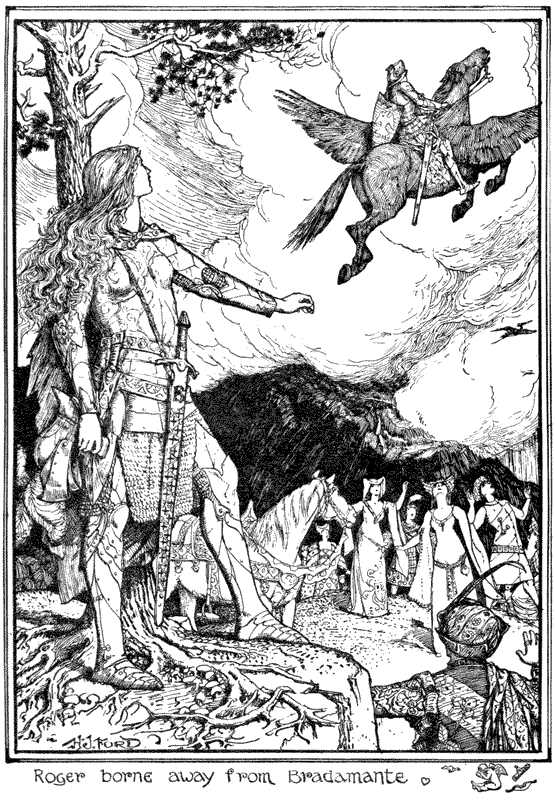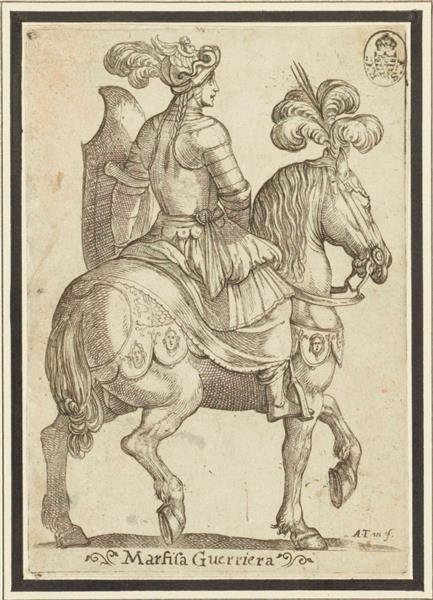There are two myths about scifi/fantasy that refuse to die and must need be repeatedly bludgeoned back down – that women have historically been excluded from the industry and that there is a serious lack of strong women characters in the genre. In my last post I talked about the Queen of Space Opera, Leigh Brackett, and highlighted some of her work. So this time let’s have a look at a Strong Female Character™!
This one predates Brackett by about 500 years and came to my attention through my reading of Bulfinch’s Legends of Charlemagne (the Matter of France being one of my blind spots). Behold – the badass babe Bradamante!

Now I actually enjoy the Song of Ice and Fire books, by and large. But there are a lot of legitimate criticisms to be leveled against Martin. To say that he often does his characters disservice is an understatement. In this particular case, I’m thinking of how unfortunate a creature we find in Brienne of Tarth when compared to our lady Bradamante. She’s the only woman who can compete in a man’s world on a man’s level! And of course she’s ugly and mannish, lacking in both grace and femininity. But how else would we know that she’s tough and strong?
Well, get a load of Bradamante. Bulfinch introduces her to us in media res, in the midst of battle. Her future husband, the Saracen Rogero, spies her engaged in combat with another Moorish knight (though at this point he is unaware of her sex) and chivalrously informs her that her army is fleeing and that she had best join them. Ultimately she is unable to catch up to her allies and Rogero insists on accompanying her off the field.
After introducing himself, he seeks to learn more about her. He gets much more than he expects, and here begins their legendary romance.
Having thus ended his tale, Rogero entreated a similar return of courtesy from his companion, who replied, without disguise, that she was of the race of Clermont, and sister to Rinaldo, whose fame was perhaps known to him. Rogero, much moved by this intelligence, entreated her to take off her helmet, and at the discovery of her face remained transported with delight.
While absorbed in this contemplation, an unexpected danger assailed them. A party which was placed in a wood, in order to intercept the retreating Christians, broke from its ambush upon the pair, and Bradamante, who was uncasqued, was wounded in the head. Rogero was in a fury at this attack; and Bradamante, replacing her helmet, joined him in taking speedy vengeance on their enemies. They cleared the field of them, but became separated in the pursuit, and Rogero, quitting the chase, wandered by hill and vale in search of her whom he had no sooner found than lost.
– Legends of Charlemagne
Rogero is “transported with delight” at the sight of her face. Not only is she said to possess a fighting prowess equal to the greatest knights, but she is comely, too!
The way Bradamante is portrayed alongside Rogero also gives us some insight into the best way to write strong female characters – on equal footing with men and in complement to (rather than in sacrifice of) their femininity. Note that Tolkien’s warrior-woman Eowyn received a similar treatment. Here, Rogero comes to the aid of Bradamante and then the two fight valiantly, side-by-side, against common foe. Rogero is not shamed, nor does Bradamante single-handedly whoop the ambush party before Rogero is able to join the fight.

This, in and of itself, presents an attractive and entertaining symmetry to the female hero and her relationship with the paladin Rogero. Observe – a hunky man-knight and a beautiful gal-knight, kicking ass together as a dynamic duo! But we’re not done yet!
There is a prophesy foretold of Rogero, that he would either remain a Saracen and cause the downfall of Charlemagne’s empire, or else he would marry Bradmante (something she learns from the ghost of Merlin!), convert to Christianity, and sire a line of noble heroes (though in a bummer twist he’s fated to suffer betrayal and death shortly after this). Knowing of this doom, Atlantes, a powerful Moorish sorcerer and the adoptive guardian of Rogero, kidnaps him away to a castle in the clouds so as to thwart the fate in which he becomes espoused to the beautiful woman knight.
Having been separated from him after the battle, Bradamante resolves to track and rejoin him, and in this way she learns of his fate and decides to rescue him.
Bradamante, the knight of the white plume and shield, whose sudden appearance and encounter with Sacripant we have already told, was in quest of Rogero, from whom chance had separated her, almost at the beginning of their acquaintance. After her encounter with Sacripant Bradamante pursued her way through the forest, in hopes of rejoining Rogero, and arrived at last on the brink of a fair fountain.
I won’t relate the whole story, but suffice it to say the battlemaiden saves Rogero from the enchanter. What I do want to highlight is the way in which the script is flipped here – Rogero is saved by a white knight, who is the Lady Bradamante! Brilliant!
Ultimately Rogero must fight to win her hand, and so once again do we see a balance between the two. Truly strong women are not superior to men, but equal and different. As demonstrated in the character of Bradamante, this doesn’t make them weak.
Strong woman bonus: we’re told that Rogero’s sister, Marphisa, is also a skilled and beautiful warrior.

PCBushi can also be found on Twitter or at the PCBushi blog, where he ruminates on scifi/fantasy, games, and other spheres of nerd culture.
Nice to see mention of Bulfinch’s Mythology, a great source of information and ideas for fantasy. Bradamante herself used to be much more widely known than nowadays; she is mentioned in a number of Renaissance works, including Ariosto’s Orlando Furioso. She even shows up in Spenser’s Faerie Queen as Britomart.
Skill in battle, beauty and courage have been part of our fantasies for a long time.
-
Yes, Bulfinch’s Mythology is quite a nice tome!
I dare say Bradamante’s fame has ebbed. Gotta keep her name out there!
Pretty interesting stuff. The idea of the “Action Girl” is older than most people realize.
-
Yes!
Good post! With his usual erudition, Roy Thomas made Bradamante a major part of his Carolingian Sword & sorcery comic, ARAK.
-
Interesting! Didn’t come up in the first page or two of my Google searching, but I’m gratified to hear it. I *did* notice that there are a number of Final Fantasy entries (mostly for weapons, I think) named after Bradamante. Leave it to the Japanese!
-
Slight correction. Roy Thomas created VALDA, the DAUGHTER of Bradamante, for his Arak comic. The adventures of Arak take place after the Battle of Roncevalles.
https://en.wikipedia.org/wiki/Valda_the_Iron_Maiden
Feminist informed criticism is really nothing more than rich white women lamenting their fate. No one who identifies Irish, Italian, German, Spanish, etc…could possibly buy into the weak, exploited, woman myth advanced by feminist theorists.
Betty Friedan is generally credited with launching Second Wave Feminism with her, The Feminine Mystique; when Friedan wrote that book she lived in a mansion on the Hudson and had a maid at her beck and call. Most women (and men) wish they suffered as much.
That such a flawed perspective came to inform both literary criticism and SciFi and Fantasy should give one pause. It certainly explains the rise of the Mary Sue. Consider two female protagonists in SciFi, Ripley in Alien 1 and 2 and Rey in The Force Awakens.
One character is the creation of delusional feminism, and lacks depth and believability while the other does not; can you guess which is which? Which is Bradmante and which is Mary Sue? Obviously, Ripley is Bradamante, and Rey is Mary Sue. Which is the better more fully realized character? Ripley of course.
Tolkien advised to never “point outside of the story,” that is, maintain the created reality, never break the spell created by the telling of the tale. The Rey character never develops any depth, she’s two dimensional, she never becomes a believable character.
As a result, the telling of the tale is broken and you become aware it’s all make believe. Rey then invites condescension, “Do that steely eyed rocket man look for me, Rey!” Ripley….not so much. Is there a better line in all action adventure movies than, “GET AWAY FROM HER, YOU BITCH!” as Ripley girds for battle? I don’t think so.
-
Joe
Wanna bet? If you read the contemporary feminist stuff say in Catalan Spanish and French you get something far more insidious:women suffer from gender violence of the patricarchy with a dash of false consciousness and internal colonialism.
It’s really insufferable and tedious to read this stuff.
So far the literature hasn’t been infected with this crap but you read this stuff in the papers.xavier
Xavier, Nice post. I appreciate the feedback, some clarification, where I come from N.E. USA, someone becomes “white” when their mind becomes “internally colonized” as you say. Someone could be born in France, or, Spain and by adopting views antithetical to Frenchness, or, Spanishness, they are no longer either in any meaningful sense of the terms. Instead, they become “white” or some other term is substituted, usually a very narrow, shallow term pumped full of meaningless identification.
-
Joe
Yup and let me give you an example of this crap it’s in Catalan but if you put it through the google tranlate blender it’ll sound pretty much the same.
Be ready for transfeminism (feminism that cuts across race class and ideology)And the sermons about cisgender privilege
http://www.nuvol.com/entrevistes/kit-de-supervivencia-de-bel-olid/
xavier
Camilla in the Aeneid is even older than Dame Bradamante.
-
There you go! Plenty of strong female characters in fiction!
-
Thanks for the insight, John! I’ve been mulling around in my mind Lepanto, Fatima, Bradamarte, Tolkien, the Muslim conversion experience, Iron Chamber of Memories, and other things not suitable for discussion on the Internet, more info is always appreciated. A great story is shaping up!